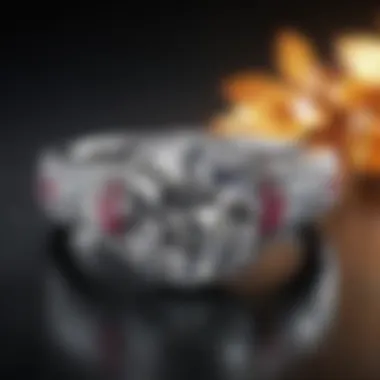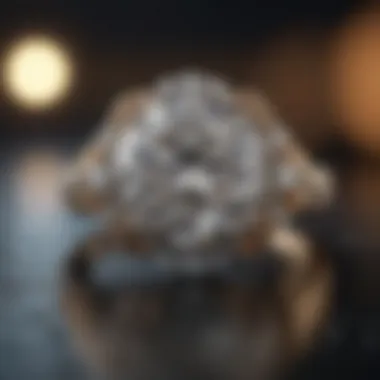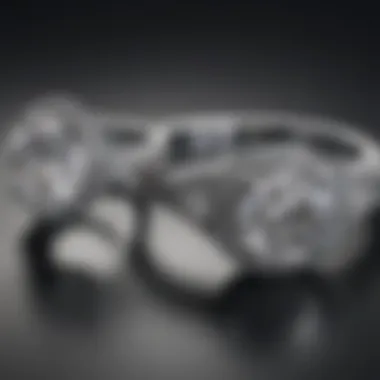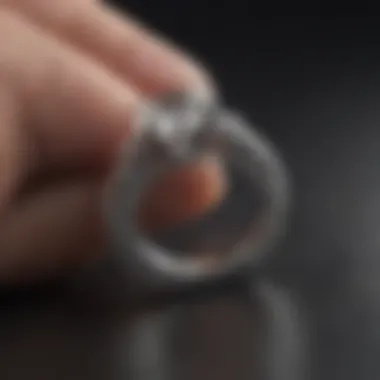Swarovski Engagement Rings vs. Diamonds: A Deep Dive


Intro
Engagement rings serve not only as symbols of love but also as reflections of personal values and choices. When it comes to selecting a ring, the choice between Swarovski engagement rings and traditional diamond rings can be quite significant. This article examines the distinct qualities between these two types of gemstones, providing insights into their pricing, craftsmanship, cultural relevance, and marketplace perspectives. By delving into their definitions and histories, readers can gain a deeper understanding of which gem aligns better with their preferences.
Gemstone Overview
Definition of Gemstones
Gemstones are natural or artificial minerals often cut and polished for use in jewelry. They can range significantly in rarity, color, and durability. Natural gemstones are sourced directly from the earth, whereas synthetic versions are manufactured in laboratories. Swarovski crystals are an example of synthetic gemstones created to resemble precious stones like diamonds.
Classification of Gemstones
Gemstones are classified into two major categories:
- Precious Gemstones: These include diamonds, rubies, sapphires, and emeralds. They are known for their rarity and higher market value.
- Semi-precious Gemstones: These encompass a wider range of stones, including amethyst, citrine, and turquoise, which are generally more accessible and affordable.
Swarovski crystals fall under synthetic gemstones, crafted to mimic the beauty of natural precious gemstones without the same value. This distinction provides a basis for understanding their place in the jewelry market.
Historical Significance
Origins of Gemstone Use
The use of gemstones dates back to ancient civilizations. The earliest evidence of gemstones being used for adornment can be traced to cultures around 4,000 BCE. Egyptians adorned themselves with lapis lazuli and turquoise, believing these stones held magical properties. Diamonds, first discovered in India around the 4th century BCE, were also cherished for their hardness and beauty.
Cultural Insights: Gemstones in Ancient Civilizations
Throughout history, various cultures have assigned symbolic meanings to gemstones.
- In Ancient Greece, diamonds were associated with invincibility and were thought to be tears of the gods.
- The Romans preferred emeralds for their vibrant green, associating the stone with Venus, the goddess of love.
Swarovski crystals, while lacking an ancient history, have quickly made a mark in more modern times since their creation in 1895. They are often used in fashion jewelry to resemble the sparkle of natural stones at a more accessible price point.
"Understanding the historical significance of gemstones adds depth to their current value and usage in jewelry creation."
By analyzing these elements, we gain insight into how different gemstones have been perceived and valued across different eras and societies.
Preface
The topic of engagement rings carries significant weight in the realm of gemstones and jewelry. When considering an engagement ring, individuals often lean towards two prominent options: Swarovski engagement rings and diamonds. Each offers unique attributes that cater to a variety of tastes, budgets, and personal values.
Understanding why individuals gravitate toward either choice is essential. The decision between Swarovski and diamond rings encompasses factors like aesthetic appeal, pricing dynamics, and emotional significance. Many seek the enduring quality associated with diamonds, while others find beauty in the innovative craftsmanship of Swarovski crystals.
This article aims to break down the primary elements that differentiate these two choices. From the glimmering allure of Swarovski crystals to the natural splendor of diamonds, each ring type brings its own value and meaning. Furthermore, the emotional connections attached to these pieces can influence choices profoundly.
Exploring these differences is not merely about comparing physical attributes but also understanding the potential implications on one’s lifestyle and values. For enthusiasts, collectors, and professionals in jewelry design, a comprehensive insight into the characteristics of both items helps in making informed decisions.
As we navigate through the various sections of this article, the reader can expect a thorough examination of these distinctions. This will aid in grasping not only the aesthetic allure of both rings but also their long-term significance in personal and cultural contexts.
Understanding Swarovski Crystals
Swarovski crystals are an integral component when discussing gemstone jewelry today. Their significance extends beyond mere aesthetics, as they merge artistry with affordability. Numerous factors play into understanding Swarovski crystals, particularly in the context of engagement rings. Being informed about their attributes enables consumers to make choices aligned with their values and budget.
The History of Swarovski
Swarovski was founded in 1895 by Daniel Swarovski in Tyrol, Austria. The original aim was to create a machine that would produce crystal glass more efficiently than traditional methods. This innovation marked the beginning of an era where high-quality crystals became accessible to a wider audience.
Throughout the 20th century, Swarovski evolved into a luxury brand, synonymous with elegance and refinement. Its collaboration with designers in the fashion industry further cemented its reputation. Today, Swarovski crystals are known worldwide, with a rich heritage that underscores their exceptional quality.


Manufacturing Process of Swarovski Crystals
The production of Swarovski crystals involves precision and meticulous craftsmanship. The process starts with the selection of high-quality raw materials. This includes a proprietary blend of materials to create the perfect crystal composition.
The crystals undergo a precise cutting process. This stage is crucial as it affects the final sparkle of the crystal. Using advanced technology, artisans craft each piece meticulously, ensuring brilliance and clarity. The finishing touches involve polishing and coating, enhancing the crystals' reflection and color.
Types of Swarovski Crystals Used in Jewelry
Different styles and types of Swarovski crystals are pivotal in jewelry design. They range from classic clear crystals to vibrant colored ones. Here are some of the notable types:
- Swarovski Aurora Borealis (AB): Known for its shining rainbow effect. This is achieved through a special coating process.
- Swarovski Flat Back Crystals: Often used in embellishments and jewelry-making, these offer versatility and ease of use.
- Swarovski Pearls: These give a classic look, combining natural beauty with modern craftsmanship.
- Swarovski Elements: These are loose crystals that can be used for custom creations.
In sum, the choice of Swarovski crystals allows for endless creative possibilities, making them a preferred choice for many.
"Understanding the craftsmanship behind Swarovski crystals enhances appreciation for their place in jewelry."
Choosing Swarovski engagement rings can offer a balance of elegance and budget. It is essential to understand each aspect of these crystals to determine their suitability for individual preferences.
Characteristics of Diamonds
Diamonds represent an enduring symbol of love and commitment. Understanding the characteristics of diamonds is essential for anyone considering an engagement ring. This section will delve into the various aspects that define diamonds, from their natural formation to quality grading criteria and ethical sourcing.
The Formation of Natural Diamonds
Natural diamonds are formed deep within the Earth's mantle under conditions of extreme heat and pressure. This process can take billions of years, resulting in the creation of the crystalline structure that gives diamonds their strength and brilliance. Most diamonds found today were created over a billion years ago, which makes them a rare resource.
When volcanic eruptions occur, they bring these diamonds closer to the Earth's surface through a type of magma called kimberlite. This is why diamonds are often found in or near former volcanic sites. The geological conditions that contribute to diamond formation are intricate, making each stone unique. The rarity of these natural formations adds to their allure and value in the jewelry market.
Four Cs of Diamonds: Cut, Color, Clarity, and Carat
The quality of diamonds is usually assessed through what is known as the "Four Cs." Each factor plays a significant role in determining a diamond's value and visual appeal:
- Cut: Refers to how well the diamond has been shaped and faceted. A well-cut diamond will reflect light properly, enhancing its sparkle.
- Color: Diamonds can come in a spectrum of colors, but the most coveted are those that appear colorless. Each degree of color affects the rarity and worth.
- Clarity: This metric evaluates the presence of internal or external flaws, known as inclusions and blemishes. Higher clarity means fewer imperfections, which translates to greater value.
- Carat: Represents the weight of the diamond. Larger diamonds are more valuable, although size alone does not dictate worth without considering the other Cs.
Understanding these four Cs is critical when selecting a diamond. Each characteristic contributes not only to the esthetic beauty of the stone but also to its financial investment potential.
Ethical Sourcing of Diamonds
In recent years, the ethical sourcing of diamonds has become an important consideration for consumers. The term "blood diamonds" refers to gems mined in war zones and sold to finance armed conflict. Many consumers now prioritize purchasing diamonds from ethical sources to avoid supporting these practices.
Various initiatives and certifications, such as the Kimberley Process, have been implemented to help ensure that diamonds are sourced responsibly. Consumers can seek out sellers that provide transparent sourcing information. This awareness impacts consumer choices and encourages sellers to uphold ethical buying practices. Buying ethical diamonds often means paying a premium, but for many, this aligns with personal values and beliefs.
"Ethically sourced diamonds not only represent love but also commitment to social responsibility."
Understanding the characteristics of diamonds will empower consumers to make knowledgeable choices. Whether it is the natural formation, quality factors, or ethical considerations, each element enhances the depth and significance associated with diamonds in engagement rings.
Comparative Analysis of Quality
The evaluation of quality between Swarovski engagement rings and natural diamonds is critical for buyers seeking to make an informed decision. Quality encompasses appearance, inherent value, and practical durability. Each element contributes significantly to how the rings are perceived and their longevity in wear. Understanding these qualities may guide consumers not just in choosing the right piece but also in appreciating the craftsmanship that goes into each type of gemstone.
Lustrous Appearance and Sparkle
Swarovski crystals are renowned for their exceptional clarity and brilliance. These crystals are created using advanced technology that enhances their reflective properties. The precision cut of Swarovski crystals ensures that they catch light effectively, contributing to their overall shine. In contrast, natural diamonds possess an inherent sparkle due to their unique crystalline structure and the way they refract light.
The sparkle of a diamond is further enhanced by the "Four Cs"—cut, color, clarity, and carat weight—which collectively determine its quality. A well-cut diamond will exhibit maximum brilliance, and many people prioritize this when selecting an engagement ring. While Swarovski crystals can achieve a dazzling appearance, they often do not match the depth of fire characteristic of high-quality diamonds.
In an aesthetic comparison, both types can look stunning. However, for those who prioritize the traditional aspects of jewelry, a diamond may still hold more significant visual appeal due to its natural properties. Ultimately, it depends on personal preference when choosing between the two.
Durability and Longevity


When it comes to durability, diamonds are significantly more robust than Swarovski crystals. A diamond, rated at 10 on the Mohs scale of hardness, is known for its ability to withstand scratches and damage. This makes diamonds a preferable choice for everyday wear, especially in engagement rings, which are often worn constantly.
Conversely, Swarovski crystals are composed of glass and tend to be more prone to scratching and chipping. Their hardness is rated lower on the Mohs scale, usually around a 5. This means they may require more careful handling and maintenance. Buyers should be aware of this when considering a long-term investment in jewelry.
For those who desire a piece that will endure over time, a diamond ring offers superior longevity. However, Swarovski engagement rings may appeal to consumers looking for a more affordable option that still presents an attractive appearance without the concern of long-lasting wear.
"Ultimately, the choice between Swarovski and diamond engagement rings should consider not only the visual attributes but also the practical longevity for daily use."
In summary, the comparative analysis of quality regarding lustrous appearance and durability illustrates significant differences between Swarovski and diamonds. Understanding these distinctions gives consumers the information they need to select the best engagement ring that aligns with their needs and lifestyle.
Price Comparison
Price is a critical factor when it comes to selecting an engagement ring. Understanding the cost differences between Swarovski engagement rings and traditional diamonds can significantly influence buyer decisions. This section will explore the specific elements that contribute to the pricing of these two types of rings, as well as the benefits and considerations that come with them.
A thoughtful price comparison allows potential buyers to evaluate their options in line with personal budgets while considering long-term value.
Cost of Swarovski Engagement Rings
Swarovski engagement rings are known for their affordability when compared to natural diamonds. The price range of Swarovski rings typically varies between a few hundred to a couple of thousand dollars. A key factor in their lower prices is the manufacturing process of Swarovski crystals, which involve cutting and polishing glass rather than mining rare minerals. The cost of the raw materials, craftsmanship, and brand reputation also play significant roles.
Swarovski crystals offer a beautiful luster and an appealing look but are mass-produced, resulting in lower market costs. Buyers appreciate the elegant designs and options available that fit various tastes and styles. Certainly, these rings are ideal for individuals who want a visually stunning piece without a heftier financial burden.
Pricing Factors for Diamonds
In contrast, the pricing of diamond engagement rings can be much more complex. They are influenced by multiple factors including the Four Cs, which are cut, color, clarity, and carat weight. Each of these characteristics contributes to the overall quality and cost of the diamond. Moreover, the rarity of natural diamonds adds to their price; exceptional diamonds can command significantly higher prices in the market.
- Cut: The shape and quality of the diamond’s cut determine its brilliance. Higher quality cuts can increase prices considerably.
- Color: Diamonds range in color from colorless to shades of yellow or brown. The more colorless the diamond, the higher the price.
- Clarity: Clarity measures internal or external imperfections. Higher clarity diamonds are rarer and pricier.
- Carat Weight: The weight of a diamond affects its overall size. Larger carats generally lead to significantly higher costs.
Investment Value of Diamonds
Diamonds are often viewed as more than just jewelry; they can represent significant investments over time. Contrary to the affordability of Swarovski crystals, diamonds may retain their value and in some cases appreciate. This makes diamond engagement rings a choice not only bound by tradition but also a financial consideration for many buyers.
While a Swarovski ring shines bright upon purchase, a natural diamond ring can serve as an investment and heirloom that may hold its worth for future generations.
"Investing in a diamond ring often symbolizes enduring love, but its value may also prove wise over time."
Cultural and Emotional Significance
The choice of an engagement ring is not merely a personal one; it reflects deeper cultural traditions and emotional expressions. In this section, we will explore how both Swarovski and diamond engagement rings resonate with individuals and societies, highlighting their respective significances and what they symbolize.
Symbolism of Diamonds in Engagements
Diamonds have long been associated with love, commitment, and eternity. Their hardness symbolizes strength, making them a fitting choice for something as enduring as a marriage. Traditionally, the phrase "A diamond is forever" has underscored this sentiment, influencing consumer behavior significantly.
Many cultures hold diamonds in high regard, often viewing them as a status symbol. The rarity and value of natural diamonds can signify wealth and success, adding to their allure. However, their importance transcends mere monetary value; diamonds often carry emotional weight. They are often passed down through generations, making them a family heirloom that strengthens personal bonds.
"The diamond engagement ring has become an institution within marriage traditions, offering a tangible representation of love and commitment between partners."
Swarovski's Appeal in Contemporary Jewelry
Swarovski engagement rings, made from precision-cut crystals, cater to a modern audience with different values. While they may not possess the same natural properties as diamonds, their appeal lies in their affordability, versatility, and wide range of designs. Young couples, particularly millennials, may gravitate towards Swarovski as a symbol of unique expression rather than traditional norms.
The brand is known for its contemporary designs, which often reflect current fashion trends. This adaptability makes Swarovski rings appealing for those who wish to wear something that represents their individual style. As sustainability becomes increasingly important in contemporary jewelry choices, Swarovski offers a synthetic alternative that aligns with the ethical considerations of many consumers.
In summary, the cultural and emotional significance of engagement rings is profound. While diamonds symbolize enduring love and tradition, Swarovski rings offer modern aesthetics with a focus on individuality and ethical considerations. This dichotomy illustrates the evolving landscape of engagement ring choices, underscoring the importance of personal values in the decision-making process.
Market Trends
Understanding market trends is crucial when comparing Swarovski engagement rings and diamonds. The jewelry market is constantly evolving, influenced by consumer demand, societal values, and economic factors. This section will explore how these trends impact the choices of engagement rings today.


Shopping for jewelry, especially an engagement ring, is a significant decision. Many factors come into play, including style, material, and price. By recognizing current market trends, consumers can make informed purchases that align with their preferences and values. Not only does this guide individual choices, but it also reflects broader shifts in the jewelry industry.
Consumer Preferences in Jewelry Choices
As values and lifestyles change, so do consumer preferences in jewelry. Increasingly, shoppers are prioritizing personal expression and ethical sourcing. This is reflected in the growing popularity of Swarovski engagement rings. These rings offer unique aesthetics while being more accessible financially. In surveys, many potential buyers express a desire for customization options, which Swarovski effectively provides through their range of designs and colors.
Moreover, diamonds, while traditional, are facing scrutiny regarding their ethical sourcing. More consumers are becoming aware of the implications of diamond mining and the environmental impact associated with it. Consequently, younger generations show interest in alternatives like Swarovski crystals or lab-grown diamonds.
This shift promotes a marketplace where consumers feel empowered to choose items that resonate with their values. They seek rings that not only look beautiful but also represent their ethics.
Sustainability Trends in the Gemstone Market
Sustainability has become an pivotal topic in the gemstone market. Consumers today have a heightened awareness of environmental issues. This encompasses the patterns of production, resource extraction, and overall ecological impact. Traditional diamond mining is often criticized for its consequences on both the environment and local communities. As a result, many consumers are exploring more sustainable options.
Swarovski, for instance, positions itself as an eco-friendly alternative. The company boasts a more controlled manufacturing process, which reduces environmental harm. Recently, this focus on sustainability has led to a rise in the popularity of lab-grown diamonds, which are often perceived as more ethical and technically advanced.
Factors contributing to sustainability trends include:
- Increase in conscious consumerism.
- Demand for transparency in supply chains.
- Emphasis on eco-friendly materials and practices.
"Consumers are now more informed and expect brands to align with their values."
Choosing the Right Engagement Ring
Choosing the right engagement ring holds significant weight in the journey of engagement. It symbolizes commitment, love, and a promise of a shared future. Understanding the qualities of both Swarovski crystals and diamonds is essential for making a well-informed decision. The choice between these two options may rest upon various factors, including personal values, cultural significance, and financial considerations.
Furthermore, it can be argued that the right engagement ring transcends mere aesthetics, becoming a reflection of one's identity and values. Thus, the ability to assess what holds most importance allows for a more meaningful selection.
Assessing Personal Values and Priorities
When evaluating an engagement ring, assessing personal values and priorities plays a crucial role. Individuals may prioritize different aspects, such as origin, craftsmanship, or the inherent symbolism of the ring. For instance, some might place strong emphasis on ethical sourcing and sustainability, aligning their purchase with values that advocate for responsible jewelry production.
Others may view the allure of traditional diamonds as indispensable, considering their long-standing reputation and historical significance in engagements. The decision process becomes a dialogue between desires and convictions, leading one to choose what resonates more deeply.
In this context, reflecting on the meaning associated with engagement rings becomes fundamental. Aspects such as family traditions and cultural practices may also influence personal values, guiding individuals toward a choice that respects their heritage while embracing contemporary preferences.
Finding a Balance Between Aesthetics and Budget
The balance between aesthetics and budget is another critical dimension in choosing an engagement ring. A stunning ring is undoubtedly appealing, yet financial constraints can significantly influence purchasing decisions. Understanding the extent of one's budget aids in narrowing options without compromising on style or quality.
Swarovski engagement rings are often more affordable compared to traditional diamond rings. They usually attract those who seek an aesthetically pleasing option without bearing the financial burden that diamonds may impose. However, some may remain steadfast in their desire for diamonds, perceiving them as timeless treasures worth the investment.
Comparative exploration of features such as clarity, cut, and design can help potential buyers make a valid choice within their means. Identifying what brings personal satisfaction, be it the brilliance of a Swarovski crystal or the enduring nature of a diamond, illuminates the path to selecting the right engagement ring.
Ultimately, marrying aesthetic preferences with a realistic budget ensures that the chosen ring not only captures visual appeal but also resonates deeply with the buyer's financial circumstances.
The End
The subject of engagement rings holds significant implications for couples contemplating lifelong commitments. In this article, we evaluated various dimensions of Swarovski engagement rings as opposed to traditional diamond rings. Each type presents distinct characteristics that demand careful consideration.
When making a choice, several elements become paramount. One must evaluate the aesthetic qualities versus long-term investments. Both styles offer beauty, yet philosophical differences surface—where one tends to support a conventional narrative, the other embraces modernity and sustainability. Understanding the nature of materials also helps to inform consumer preferences and societal acceptance.
In terms of cultural significance, each ring type conveys different values and emotions, shaping the narrative surrounding one's proposal. The following aspects should resonate:
- Personal values: Does one prioritize ethical sourcing, or does brilliance and tradition reign supreme?
- Financial considerations: How will this decision affect future financial goals?
- Emotional implications: What does the choice symbolize in the context of personal relationships?
Understanding these choices allows couples to make educated decisions that reflect their unique journeys and values, fostering a deeper connection with their selected symbol of love.
With this comprehensive analysis, we hope to have illuminated the complexities involved in choosing the right engagement ring. It is a process that extends beyond mere aesthetics or price; it encapsulates emotions, choices, and values that will resonate long after the moment of exchange has passed.
Final Thoughts on Engagement Ring Choices
Decision-making in the realm of engagement rings should ultimately culminate from thorough reflection and alignment with personal ideals. Assessing the variables of appearance, cost, and significance can enhance one's appreciation of the final selection.
In summary, whether a person opts for a brilliant Swarovski piece or a classic diamond ring, ensuring the choice aligns with one's values will undoubtedly add meaningful depth to this important symbol of commitment.



